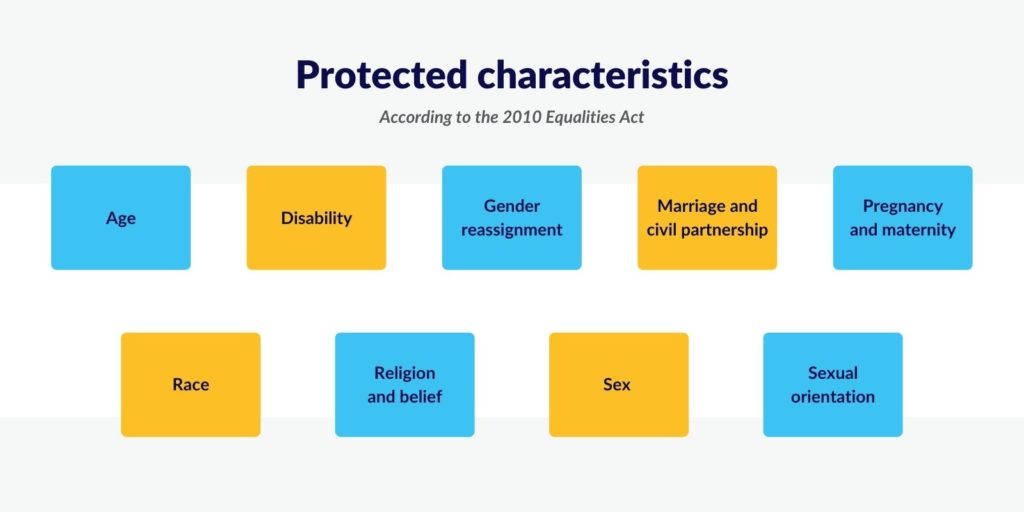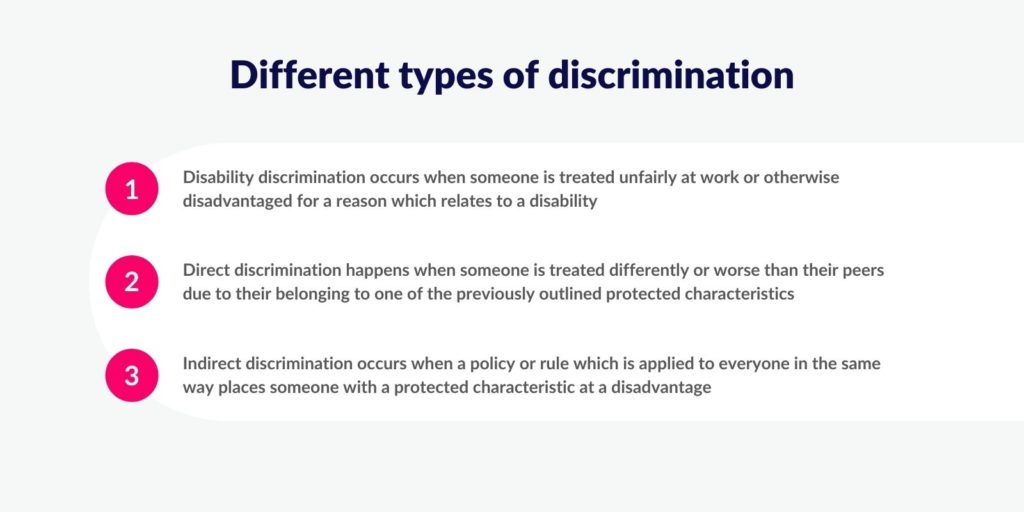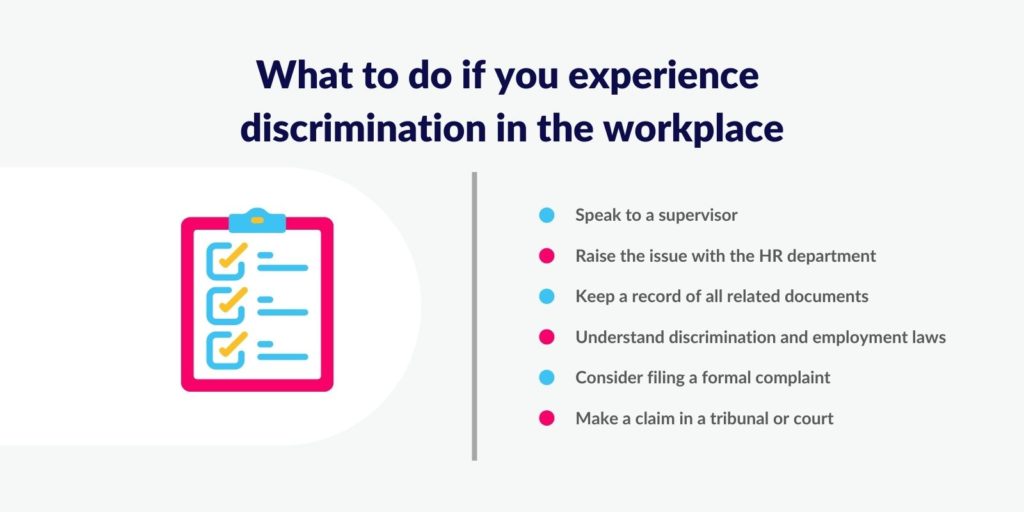Discrimination in the workplace can affect employees from all walks of life, causing irreparable harm and violating the 2010 Equalities Act. Whether it is direct or indirect discrimination, there are steps you can take if you have experienced discrimination yourself.
This article explores the various aspects of discrimination, how they affect the nine protected characteristics outlined under the Equalities Act, and what to do if you’ve been discriminated in the workplace.
What is Discrimination in the workplace?
Discrimination in the workplace occurs when an employee/employees experience unfair treatment because of their race, gender, sexuality or other protected characteristic.
This can take the form of direct discrimination, i.e. when someone is treated less favourably than their colleagues, or indirect discrimination, which occurs when rules and regulations put certain employees at a disadvantage.
While the exact figure isn’t known, some estimates place the cost to UK businesses from discrimination in the workplace at over £100 billion. The Centre for Economics and Business Research (CEBR) placed the cost of discriminatory pay practices at a staggering £127 billion.
In 2017, the European Commission released a statement concerning the disparity in pay based on gender. First Vice-President Frans Timmermans, Commissioner Marianne Thyssen and Commissioner Věra Jourová said:
“Gender equality, including equal pay for men and women, is one of the EU’s founding values. But it is still far from a reality. For the past years, the gender pay gap has basically refused to budge.
This means that women work for two months a year for free in comparison to their male colleagues. This is a shocking and unacceptable injustice in the 21st century Europe.”
The need to tackle discrimination in all its forms in the workplace is widely understood. Josh Bersin discusses the challenges faced by companies in his article, Elevating Equity and Diversity: The Challenge Of The Decade.
“It’s not enough to publish your diversity metrics: you have to make equity goals as important as your financial, legal, and other business outcomes.”
To achieve this, businesses need to cultivate a company culture which places diversity and inclusion at its core.
In this article, we’ll clarify the various types of discrimination, the protected characteristics which you need to be aware of when forming company policy, and the courses of action you can take if you’re subject to unfair treatment.
The different types of discrimination explained
According to the 2010 Equalities Act, there are a total of nine protected characteristics.

These are:
- Age
- Disability
- Gender reassignment
- Marriage and civil partnership
- Pregnancy and maternity
- Race
- Religion and belief
- Sex
- Sexual orientation
Let’s explore in more detail how these protected characteristics factor into the different types of discrimination, with examples to place them in the appropriate context.
Disability discrimination
Disability discrimination occurs when someone is treated unfairly at work or otherwise disadvantaged for a reason which relates to a disability. This could be a one-off incident or ongoing discrimination due to a work rule or policy. Physical and communication barriers at work which inhibit access are also forms of disability discrimination.
One example of disability discrimination is when a visually impaired member of staff is required to attend a virtual team presentation. For obvious reasons, this employee would be unable to participate fully in the conversation, placing them at a distinct disadvantage compared to their colleagues.
Another example is when an employee fails to receive a bonus because they have taken time off on account of a terminal illness. The employee in this situation is required to attend medical appointments and treatment sessions to protect their health and well-being, and the company should avoid persecuting them in any way because of it.
Disability discrimination doesn’t have to be intentional for it to be unlawful, so businesses need to be aware of actions they take which might fall under this definition. When such discrimination is deliberate, for example, if someone is using nicknames and other degrading and humiliating behaviour, this is considered harassment.
Victims of harassment should immediately report the incident to their company’s HR department, and in some circumstances take their case to the police to be dealt with as a hate crime.

Direct discrimination
Direct discrimination happens when someone is treated differently or worse than their peers due to their belonging to one of the previously outlined protected characteristics. While not all unfair treatment is considered unlawful, if the protected characteristic is the root cause of the treatment it is considered direct discrimination.
For instance, if an employee who suffers from bipolar disorder is told they are unable to apply for a new position because they have a mental health problem, this would be considered to be direct discrimination. An employee who is looked over for promotion because the decision-maker deemed them too young for the role would also be considered a victim of direct discrimination.
Setting smart goals which an employee is unable to complete due to a protected characteristic counts as direct discrimination. This would include setting tasks which an employee is unable to complete because of their age, race, or gender, or expecting them to participate in work which runs contrary to their religious beliefs.
Indirect discrimination
Indirect discrimination occurs when a policy or rule is applied to everyone in the same way, which places someone with a protected characteristic at a disadvantage. Such policies, practices and rules can be either informal or formal and include criteria, conditions, and qualifications.
Examples of indirect discrimination include:
- A pregnant employee requests a flexible work schedule but is turned down because company policy requires all staff to work full time
- The company requires all members of staff to work on Saturdays, running contrary to a Jewish employee’s religious beliefs which prohibit working on the sabbath
- An employer restricts the qualifications they accept only to those earned in the UK As a result, a candidate who has moved to the UK will be unable to apply for the role even if they have equivalent qualifications from their home country.

What to do if you experience discrimination in the workplace
If you’ve experienced discrimination in the workplace, there are several courses of action you can take.

These include:
Speak to a supervisor
If you’re a victim of discrimination, or witness discrimination in the workplace, you should raise the issue with your supervisor. A good manager will place employee well-being as a top priority and will be willing to intervene to resolve the issue as soon as possible.
Raise the issue with the HR department
If the situation warrants a thorough investigation and can’t be dealt with by a supervisor, contact the HR department and ask them to open a case. If the discrimination is indirect, they may be able to address a company policy which is the cause of the problem. Make sure you document the interaction in case you need a record of it in the future.
Keep a record of all related documents
In order to prove discrimination, you must keep a record of all incidents and interactions with management. Keeping a physical or digital journal is one way to do this. Note down all incidents including the time, date, location, and anyone involved in the incident.
Understand discrimination and employment laws
If the discrimination reaches a point where you may have to take things a step further, familiarise yourself with employment laws. There are a range of laws which protect people from discrimination, so understanding where you stand from a legal position is important to following through correctly.
Consider filing a formal complaint
If you have exhausted your options within the company structure, it may be time to file a formal complaint. Contact the relevant organisations and they will help you take the next step. We’ve included appropriate contacts in the resources section below which you can use.
Make a claim in a tribunal or court
Taking court action can be a long and painful process, but sometimes no other avenues are open to someone facing discrimination. It can also be expensive, so before taking this step you should be mindful that if you lose you may face large legal costs. Before making a discrimination claim, speak to a solicitor to get their advice on how to proceed.
Resources
There are a number of useful contacts you can approach if you find yourself subjected to discrimination in the workplace.
- Contact the Citizens Advice Bureau for general advice on your rights and options
- Get in touch with Acas – they will help you understand discrimination and the law, and what you can do to file a complaint
- Contact the government’s Equality Advisory Support Service, formerly the Equality and Human Rights Commission





